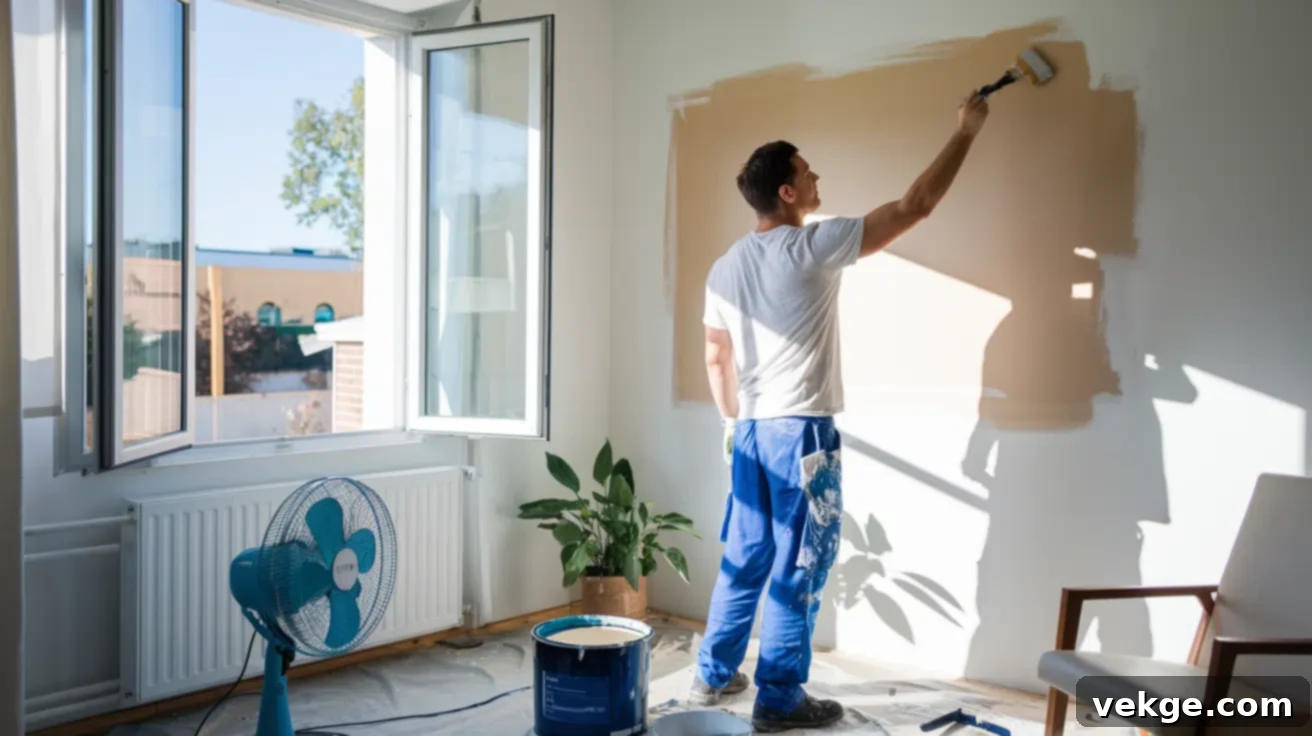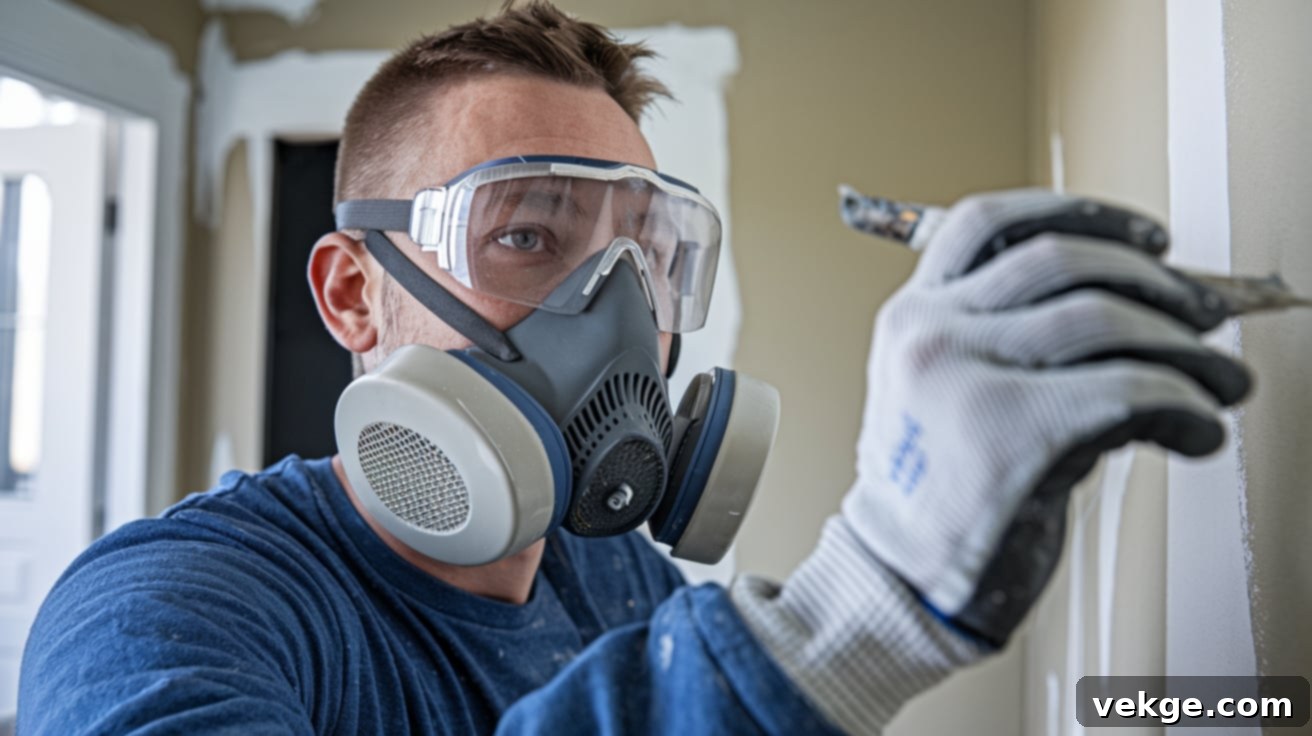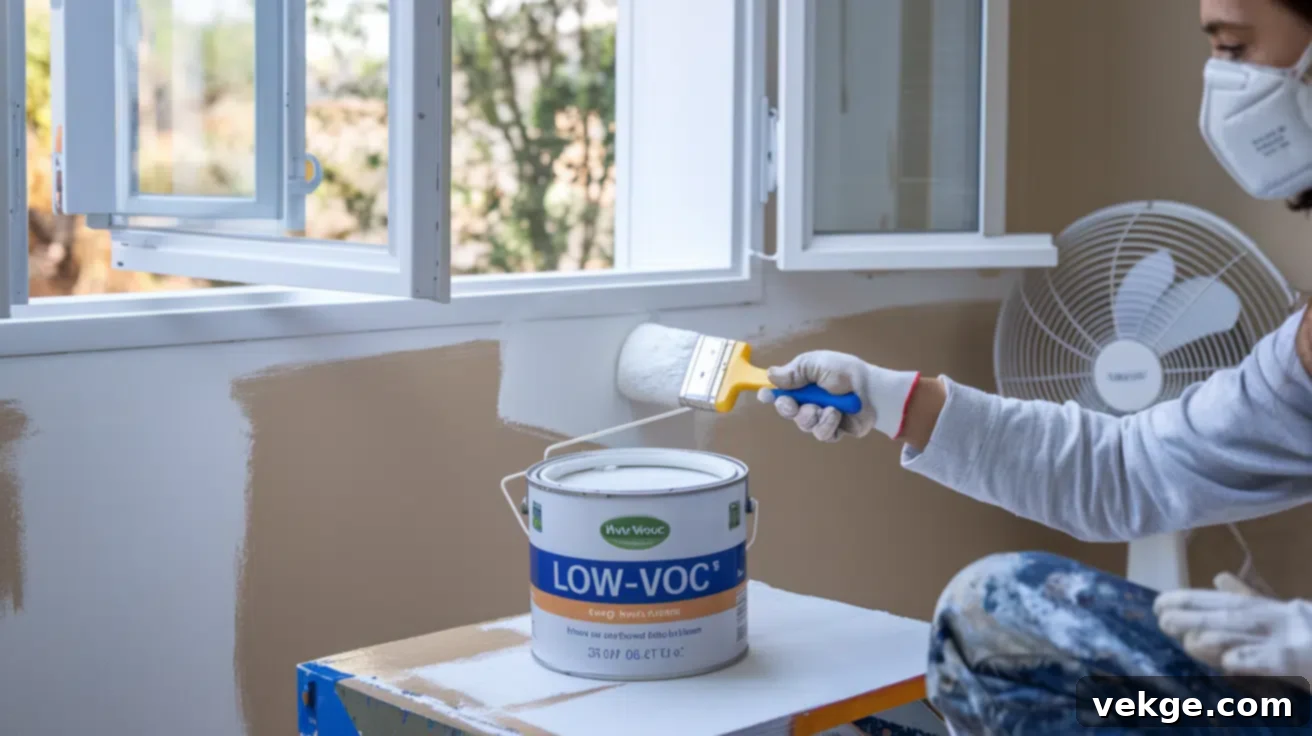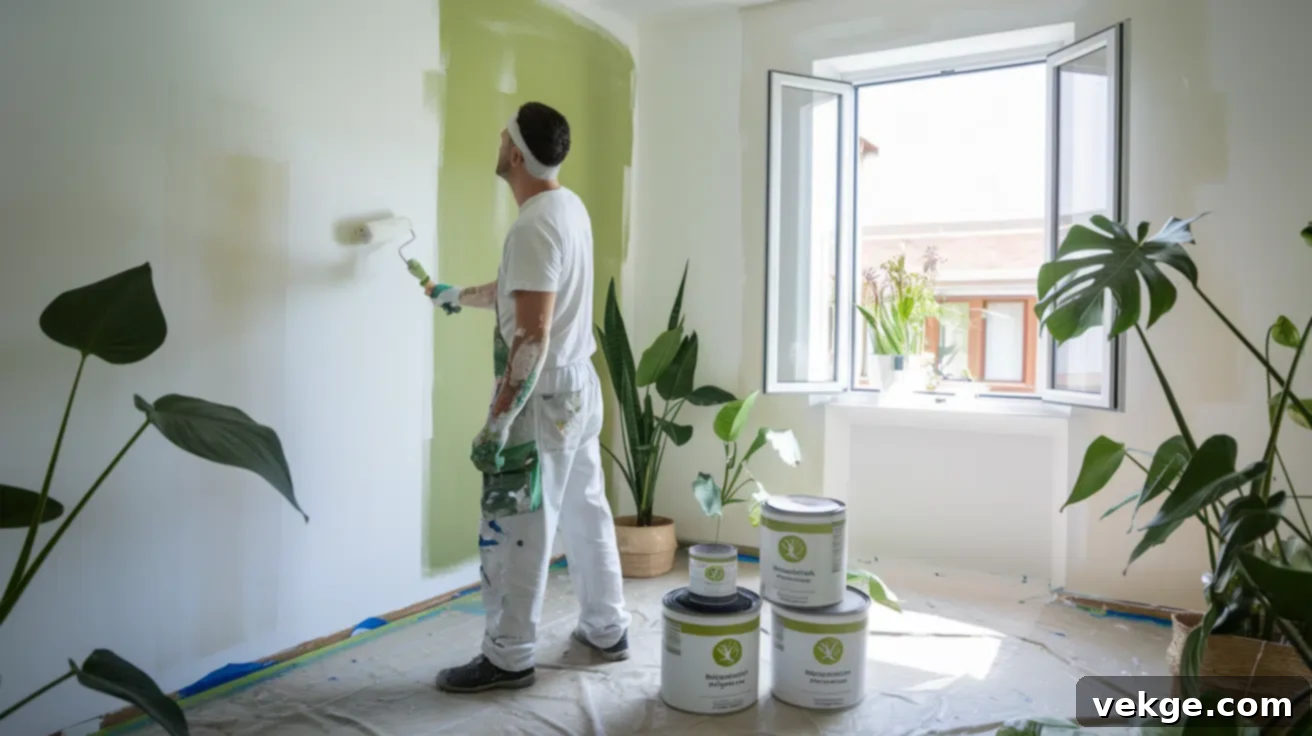The Ultimate Guide to VOC Paint: Risks, Low-VOC Alternatives, and Healthier Home Painting
Are you concerned about the potentially harmful chemicals lurking in traditional paints? You’re right to be. Many conventional paints contain Volatile Organic Compounds, or VOCs – chemicals that readily evaporate into the air as the paint dries. These airborne compounds can significantly impact your health and the indoor air quality of your home, turning a fresh coat of paint into a source of hidden hazards.
This comprehensive guide will demystify VOC paint, detailing the risks it poses to both human health and the environment. More importantly, we’ll equip you with practical strategies to drastically reduce your exposure to these chemicals. You’ll also be introduced to safer, eco-conscious alternatives like low-VOC and no-VOC paints, empowering you to make choices that foster a healthier living space for you and your loved ones.
By the time you finish reading, you’ll possess the knowledge and tools to protect yourself and your family during your next painting project, ensuring beauty without compromising well-being. Let’s delve into the world of paint chemistry and discover how to paint smarter, not harder.
What are VOCs, and Why are They Prevalent in Paint?
VOCs, an acronym for Volatile Organic Compounds, are carbon-containing chemicals that vaporize at room temperature. They are ubiquitous in various products, but their presence in many paints is particularly noteworthy. As paint cures and dries, these compounds off-gas, releasing gases into the surrounding atmosphere, which directly affects indoor air quality and can have significant health implications. VOCs can be either naturally occurring (e.g., from plants) or synthetically manufactured, with the latter being more common in industrial and household products like paint.
In paint formulations, VOCs serve crucial functions. Primarily, they act as solvents, designed to dissolve the paint’s solid ingredients – such as resins, pigments, and additives – into a smooth, liquid consistency. This solvent action is essential for allowing paint to spread evenly and flawlessly across surfaces. Furthermore, VOCs play a role in controlling drying times and helping the paint form a continuous, durable film. Common VOCs found in traditional paints include chemicals like formaldehyde, benzene, toluene, xylene, and acetone. While these compounds are effective at maintaining paint consistency and facilitating application, their evaporative nature means they continuously release harmful gases during and after the painting process, posing a threat to both health and environmental integrity.
How VOCs Function Within Paint Formulations
The operational mechanism of VOCs in paint is fundamental to its application and performance characteristics. As mentioned, VOCs function primarily as solvents, ensuring the paint remains in a liquid state, allowing for smooth and effortless application onto diverse surfaces. This liquid form enables the paint to spread uniformly, creating an even coat without clumping or streaking.
Beyond their role as carriers, VOCs also influence the paint’s drying speed. They evaporate relatively quickly, allowing the paint film to solidify and cure in a reasonable timeframe, which enhances application efficiency. However, this very process of evaporation is what leads to their release into the air. This rapid vaporization of solvents is the primary reason for the distinctive and often pungent “paint smell” that permeates freshly painted rooms, a clear indicator of VOCs being actively released into your indoor environment.
Health and Environmental Risks Associated with VOC Paint
The presence of VOCs in paint is not merely an aesthetic concern; it carries substantial health and environmental risks. Exposure can manifest in immediate, short-term symptoms, but also contribute to severe, long-term diseases and broader ecological damage. Understanding these risks is the first step towards choosing safer alternatives.
Short-Term Health Effects of VOC Exposure
Direct exposure to VOCs during or immediately after painting can trigger a range of acute symptoms. Individuals may experience respiratory irritation, leading to uncomfortable issues such as persistent coughing, noticeable wheezing, or bothersome shortness of breath. Beyond respiratory distress, neurological effects are common, presenting as sudden headaches, disorienting dizziness, and uncomfortable nausea. Other immediate effects can include eye, nose, and throat irritation, skin rashes, or even fatigue.
The severity of these symptoms is highly variable, depending on several factors: the concentration level of VOCs in the air, the duration of exposure, and an individual’s unique sensitivity to specific chemicals. Children, the elderly, and individuals with pre-existing respiratory conditions like asthma are often more vulnerable to these immediate impacts. Implementing proper ventilation and utilizing appropriate protective gear are crucial strategies to significantly minimize the risk of experiencing these unpleasant short-term health effects when working with paints indoors.
Long-Term Health Risks from Chronic VOC Exposure
While short-term effects are distressing, continuous or repeated exposure to elevated levels of VOCs in paint can lead to much more severe and insidious health problems over an extended period. The cumulative effect of these chemicals can be profoundly damaging.
Prolonged exposure has been directly linked to the development and exacerbation of chronic respiratory diseases, including conditions such as persistent asthma, chronic bronchitis, and other lung ailments. Of even greater concern, long-term exposure to certain VOCs, particularly chemicals like benzene and formaldehyde, has been identified as contributing to an increased risk of various types of cancer, most notably lung cancer and leukemia. Moreover, VOCs are known to place stress on vital internal organs; chronic exposure can contribute to liver and kidney damage, impairing their detoxification functions. Some VOCs are also considered neurotoxic, potentially causing neurological damage or contributing to cognitive impairments over time. For pregnant women, exposure to certain VOCs has been associated with developmental issues in fetuses. Given these serious potential consequences, meticulous precautions are not merely advisable but absolutely essential for ensuring long-term health and safety.
Environmental Impact of VOCs
The adverse effects of VOCs extend far beyond human health, contributing significantly to widespread environmental pollution. When VOCs evaporate from paint and other products, they don’t simply disappear. Instead, they react with other airborne chemicals, particularly nitrogen oxides, in the presence of sunlight. This photochemical reaction forms ground-level ozone, which is a major, harmful component of smog.
Ground-level ozone is detrimental to both the environment and human health. Environmentally, it harms vegetation, damages crops, and can negatively impact entire ecosystems. It also contributes to climate change by acting as a greenhouse gas. Indoors, the accumulation of VOCs results in significantly poor air quality, making living and working spaces less habitable and sustainable. This indoor pollution is a silent threat, with potential long-term health effects for occupants. By consciously choosing low-VOC or no-VOC paints, consumers can play a direct role in reducing the environmental burden of these chemicals and profoundly improving the air quality within their homes and communities.
VOC-Free and Low-VOC Paint Alternatives for a Healthier Home
Fortunately, the paint industry has evolved, offering a growing array of healthier and more sustainable options. Low-VOC and no-VOC paints represent a significant leap forward, designed specifically to reduce harmful emissions and provide safer alternatives for both indoor air quality and the broader environment. These innovations allow homeowners to achieve beautiful results without compromising on health or ecological responsibility.
Understanding Low-VOC Paint
Low-VOC paint formulations are engineered to contain a substantially smaller quantity of volatile organic compounds compared to their traditional counterparts. Typically, these paints adhere to stringent industry standards, often containing under 50 grams of VOCs per liter, though specific standards can vary by region and certification. This reduced VOC content makes them a considerably safer choice, not only for the immediate environment during and after painting but also for the long-term indoor air quality of your home.
One of the most immediate benefits noticed by users is the significantly less intense odor. Unlike regular paints that emit a strong, lingering chemical smell, low-VOC options have a milder, often barely perceptible scent. This contributes to fewer harmful chemicals being released into the air during the crucial application and drying phases. Consequently, these paints are an excellent choice for individuals with allergies, chemical sensitivities, or pre-existing respiratory issues, as they dramatically reduce the potential for irritation and adverse health reactions. Many low-VOC paints are also water-based, making cleanup easier and further reducing the need for harsh chemical solvents.
What Defines No-VOC Paint?
Taking health and environmental considerations a step further, no-VOC paint is formulated to contain virtually zero volatile organic compounds. While a minuscule amount (often less than 5 grams per liter) might still be present due to impurities in pigments or other trace elements, these paints are considered the safest option available for health-conscious consumers and environmental stewardship. They are particularly ideal for individuals who are highly sensitive to chemical odors, suffer from severe allergies, or wish to minimize their exposure to any potential toxins whatsoever.
A common misconception is that no-VOC paints compromise on performance. On the contrary, modern no-VOC formulations offer the same smooth application, excellent coverage, and durable finish as traditional paints, all without the accompanying harmful emissions. These advanced paints are often water-based and utilize innovative binders and pigments that do not rely on toxic solvents. No-VOC paint is especially beneficial for environments where air quality is paramount, such as children’s nurseries, bedrooms, healthcare facilities, and homes where pregnant women or individuals with severe respiratory conditions reside, as they pose no discernible risk to indoor air quality or long-term health.
Popular Low-VOC and No-VOC Paint Brands
The market now offers a variety of high-quality, eco-friendly paint options from reputable brands that prioritize both performance and safety. Well-known manufacturers like Sherwin-Williams and Benjamin Moore have developed dedicated low-VOC lines, while specialized eco-friendly companies such as ECOS Paints focus exclusively on no-VOC solutions. Here’s a quick overview of some popular choices:
|
Brand |
Line/Series |
VOC Level |
Features |
|
Sherwin-Williams |
Harmony |
Low-VOC |
Excellent hide and coverage, rich color, durable finish, and very low chemical emissions with odor-eliminating technology. |
|
Benjamin Moore |
Aura |
Low-VOC |
Exceptional durability, vibrant colors, superior coverage, and offers environmentally friendly options with Gennex® Color Technology. |
|
ECOS Paints |
Various |
No-VOC |
Truly zero VOC, non-toxic, sustainable, safe for highly sensitive individuals, and perfect for nurseries or pet-friendly homes. |
These brands exemplify how high-quality, eco-friendly options can deliver exceptional performance without compromising health or environmental values. They offer beautiful finishes, long-lasting durability, and peace of mind, making them ideal choices for health-conscious and environmentally aware homeowners looking for sustainable painting solutions.
How to Minimize VOC Exposure During Your Painting Project
Even when opting for low-VOC paints, or if you must work with traditional paints, implementing proper precautions is critical to safeguard your health. Reducing VOC exposure during painting requires a multi-faceted approach involving effective ventilation, appropriate protective gear, and smart painting techniques to ensure a safer indoor environment throughout and after the project.
Implementing Proper Ventilation

Ventilation is arguably the single most important factor in minimizing VOC exposure. Before you even open a paint can, ensure that windows and doors in the area are wide open to facilitate robust cross-ventilation. This creates a clear path for fresh air to enter and VOC-laden air to exit. To enhance airflow and accelerate the drying process – which, in turn, helps VOCs dissipate more quickly and safely – strategically place fans. Position one fan facing out of a window to exhaust stale air and another fan facing into the room to draw in fresh air. If possible, paint during cooler, less humid parts of the day, as this can also aid in faster drying and better air circulation. It’s crucial to avoid sealing off rooms immediately after painting; instead, maintain good airflow for at least 48 to 72 hours, or even longer, especially if a strong odor persists. Consistent and effective airflow significantly reduces the concentration of VOCs indoors, making the space safer to occupy much sooner.
Utilizing Essential Protective Gear

Wearing appropriate protective gear is absolutely essential, particularly when handling paints that contain higher levels of VOCs, or if you’re working in an area where ventilation is less than optimal. Do not rely on simple dust masks; instead, use a high-quality respirator specifically designed to filter out organic vapors. These respirators feature activated charcoal cartridges that effectively absorb harmful fumes, preventing them from entering your respiratory system. Disposable respirators rated for organic vapors are readily available at hardware stores. Additionally, chemical-resistant gloves are crucial to prevent direct skin contact with paint, which can cause irritation or allow chemicals to be absorbed into the bloodstream. Safety goggles are equally important to shield your eyes from splashes and irritating fumes. It’s imperative to wear these protective items diligently, especially in poorly ventilated environments or when working with solvent-based paints. This protective equipment acts as a critical barrier between you and the hazardous chemicals, drastically reducing your risk of inhalation, skin irritation, and potential long-term health complications.
Smart Painting Techniques to Reduce VOCs

Minimizing VOC exposure extends beyond just selecting the right paint; it also involves employing smart application methods. Here are effective ways to further reduce VOC levels during your painting project:
- Apply Paint in Thin, Even Layers: Instead of applying a single thick, heavy coat, opt for multiple thin layers. Thin coats dry faster, which inherently limits the duration and intensity of chemical release. This technique not only reduces VOC off-gassing but also often leads to a smoother, more professional-looking finish.
- Prioritize Brushes or Rollers Over Spray Cans: Whenever possible, choose to apply paint with traditional brushes or rollers. Spray painting atomizes the paint into fine airborne particles, dramatically increasing the surface area for VOC evaporation and making inhalation much more likely. Brushes and rollers keep the paint more contained and closer to the surface.
- Always Choose Low- or No-VOC Paint: This is the most fundamental and impactful choice you can make. By selecting paints specifically formulated to emit minimal (or zero) volatile organic compounds, you’re addressing the problem at its source. Look for certifications like Green Seal or MPI to ensure the product meets strict standards.
- Ensure Consistent and Strong Ventilation: Reiterate the importance of painting during times of mild weather when windows and doors can remain open for extended periods. Utilize fans to create a strong airflow, drawing fresh air in and expelling chemical-laden air out. This rapid air exchange is crucial for dispersing VOCs quickly and maintaining healthy indoor air quality. Continue ventilation for several days after painting.
- Proper Storage and Disposal: After painting, seal paint cans tightly and store them in a well-ventilated area away from living spaces. Dispose of leftover paints and painting materials according to local hazardous waste regulations, never pour them down drains or directly into the environment.
- Consider Air Purifiers: While not a substitute for ventilation, a high-quality air purifier with an activated carbon filter can help absorb residual VOCs in the air after the initial drying period, providing an extra layer of protection.
How Long Do VOCs Last After Painting? The Off-Gassing Timeline
A common concern for homeowners is understanding how long VOCs remain a threat in the air after a painting project is complete. The duration of VOC off-gassing can vary significantly, depending on a multitude of factors, including the specific type of paint used, environmental conditions (temperature and humidity), the number of coats applied, and the ventilation effectiveness.
Generally, the most intense period of VOC release occurs within the first few hours to 2-3 days after painting, as the bulk of the solvents evaporate. During this phase, the strong “paint smell” is most noticeable. However, VOCs can continue to off-gas at lower levels for a much longer period. Even low-VOC and no-VOC paints, while significantly safer, are not entirely inert and can still release trace amounts of chemicals over time. Traditional, high-VOC oil-based paints, in particular, can emit VOCs for weeks or even months, contributing to a lingering chemical odor.
Factors influencing off-gassing duration include: high humidity, which slows down drying; cooler temperatures, which also prolong evaporation; poor ventilation, which allows VOCs to accumulate; and multiple thick coats of paint, which release more chemicals over a longer period. To ensure it’s truly safe to re-enter and fully occupy painted rooms, especially for sensitive individuals, it’s best to maintain robust ventilation for at least 48-72 hours. For higher VOC paints or for maximum caution, extending this ventilation period to a week or more is advisable. Using air purifiers with activated carbon filters during and after this period can also help to actively remove airborne VOCs, making the space safer to breathe sooner and ensuring a healthier indoor environment for the long term.
Conclusion: Painting Your Way to a Healthier Home
You now possess a comprehensive understanding of VOC paint, the inherent health and environmental risks it carries, and the powerful alternatives available to you. Making informed decisions about the paints you use in your home is not just a preference; it’s a critical step towards safeguarding the well-being of your family and contributing to a healthier planet.
By consciously opting for low-VOC or no-VOC paints, you are making a profound choice to improve indoor air quality, eliminate harmful chemical exposure, and create a truly healthier, more breathable living environment. But the commitment doesn’t end with paint selection. Implementing proper ventilation throughout your painting process, diligently wearing protective gear, and employing smart painting techniques are equally vital steps to minimize any remaining exposure and ensure your project is completed safely.
We sincerely hope this guide empowers you to make confident, informed decisions for your next painting endeavor. Your home should be a sanctuary, and with these insights, you can ensure it remains a safe and healthy haven. Ready to deepen your knowledge of sustainable living? Explore our other blogs for more eco-friendly home tips and continue your journey towards a healthier, greener lifestyle.
